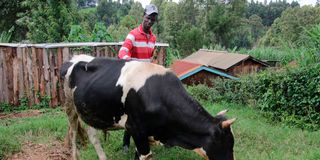How Primary school leaver mastered production of prize bulls

Eric Gitahi tends to one of his bulls at his farm in Kiriti in Nyeri County.
What you need to know:
- In the last two years, Gitahi has taken part in fairs organised by ASK in Nyeri town annually and emerged winner in the Bull Category.
- Before taking part in such shows, the highest amount Gitahi could get for a bull was Sh200,000, with a portion being set aside for the broker.
As you traverse Kiriti location in Nyeri County, the lush fields of Napier grass portray a thriving cattle farming community.
But it is not until you set foot on Eric Gitahi’s three-acre piece that the true depth of this becomes evident.
As he opens the door to the feed store, a chorus mooing from his 14 animals, recognising his presence, signals that it is time for a meal.
The bond between the farmer and his herd of cows and bulls is remarkable.
In the last two years, Gitahi has taken part in Central Kenya fairs organised by the Agricultural Society of Kenya (ASK) in Nyeri town annually and emerged winner in the Bull Category.
Gitahi has become a sensation and an inspiration to many because of that. The 30-year-old prefers to showcase bulls of the Ayrshire, Guernsey and Friesian breeds.
“I usually retain 11 cows for breeding purposes and milk,” Gitahi says.

Eric Gitahi, 30, with some of his cows in Kiriti, Nyeri County. The farmer has found a niche in rearing bulls that are sold at a tidy sum during Central National ASK fairs.
He began rearing cattle with just one animal in 2010. Gitahi gradually multiplied the herd through artificial insemination.
He would sell his animals to brokers with connection to farmers in other Mt Kenya counties, often settling for as low as Sh90,000 per bull.
This continued until mid-last year when he took part in the farmers’ annual fair for the first time.
“A friend who was an organiser at the event convinced me to enrol, citing a shortage of cattle due to the drought,” he says, adding that the show planners acknowledged the scarcity of participants and offered to cover his expenses.
There were only six farmers in the Bull Category, primarily featuring the Borana breed from ranches and conservancies.
Gitahi registered two of his two-year-old Friesian bulls, one weighing 910 kilogrammes and the other 860 kilos into the contest.
Remarkably, both bulls emerged winners and were auctioned at Sh250,000 each.
The fair provided Gitahi with valuable exposure and inspired him to implement what he had learnt through interactions with other farmers, associations and livestock experts.
The Std Eight leaver once again registered two of his Friesian bulls at the Nanyuki ASK Farmers show early this year.
Despite securing the top position, none of the bulls was sold as there was no auction.
On taking part in the Central Kenya show for the second time in September, his two Friesian bulls – aged three and two years and weighing 1,110 kilogrammes and 840 kilos, respectively – emerged top.
The two animals fetched Sh470,000 and Sh330,000 at the ASK faire auction. The event has now become Gitahi’s primary market.
Before taking part in such shows, the highest amount Gitahi could get for a bull was Sh200,000, with a portion being set aside for the broker.
“I now network with prospective buyers, including fellow farmers, effortlessly. The farmers use the bulls for breeding. Butchers also buy my animals,” he says.

Eric Gitahi operates a biogas-fuelled chaff cutter at his farm in Kiriti, Nyeri County.
Gitahi says the key to improving one’s animals is proper feeding.
“I give a calf six litres of milk for three months daily,” Gitahi says.
He incorporates shredded Napier grass and commercial feeds for weaning.
Every animal on Gitahi’s farm gets this mixture three times a day. A milking session is accompanied by a nutritious feed. His 11 cows produce 200 litres of milk per day.
The largest animal on the farm is a two-year-old Friesian bull and a five-year-old cow, each weighing well over 700 kilos.
Two and a half acres of the farm is dedicated to Napier grass. The harvested grass is shredded using a biogas-powered machine.
Gitahi advises aspiring contestants to train their calves to be friendly. This involves regular interaction, whether through walks or feeding.
“Reinforce positive behaviour with treats or gentle strokes. Misbehaviour must be punished,” he says, adding that training for the fairs includes teaching the animal to walk on a lead, stand calmly and respond to commands.
To qualify as show material, the farmer assesses the bull’s body proportions and alignment, including the straightness of the legs.
Reproductive organs should be well-developed, and the bull should exhibit strong genetic traits, be calm, manageable and maintain cleanliness.
Livestock expert Warugongo Theuri, who has also served as a judge in farmers’ competitions, says judges look at the animal’s health condition, level of production and whether it has been properly categorised in the contest.
He, however, points out that bull participation in such competitions is uncommon due to farmers’ concerns about high production costs and limited returns.
“Because of this, many of those who participate have big farms and only target prime markets,” he says.
He advises farmers to reduce the cost of bull rearing by growing their own feeds.





